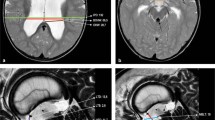Abstract
Introduction
There is often uncertainty regarding the site of the cerebrospinal fluid (CSF) block in individual patients with hydrocephalus, leading to a significant failure rate for endoscopic third ventriculostomy (ETV) when performed for unconventional pathologies such as postmeningitic and posthaemorrhagic hydrocephalus. We describe the use of lumbar air encephalography (AEG) to refine the indications for ETV in such circumstances.
Methods
Data from AEG studies used to guide indications for ETV were collected prospectively. The technique and protocol for AEG have been modified from the historical description of the procedure in the interest of safety and to minimise discomfort. In a separate evaluation, the level of the CSF block was determined by one of the authors, who was blinded to the results of the AEG, based on conventional computerised tomographic criteria. These results are compared with those obtained from the AEG.
Results
Forty-five studies were performed over a 2-year period. Thirty-seven were preinterventional, the majority of which demonstrated communicating hydrocephalus. ETV performed in five cases of non-communicating hydrocephalus was successful in each. The prediction of the level of block based on CT criteria was poor.
Conclusion
It is often difficult to determine whether hydrocephalus is communicating or not with conventional imaging in the absence of a clearly demonstrable lesional obstruction to the CSF pathways. We have found AEG helpful in excluding patients with communicating hydrocephalus from an inappropriate ETV. On the basis of our experience, we consider the modified procedure safe as long as a strict protocol is followed.



Similar content being viewed by others
References
Amacher AL, Wellington J (1984) Infantile hydrocephalus: long-term results of surgical therapy. Childs Brain 11:217–229
Bruwer GE, Van Der Westhuizen S, Lombard CJ, Schoeman JF (2004) Can CT predict the level of CSF block in tuberculous hydrocephalus? Childs Nerv Syst 20:183–187
Cinalli G, Sainte-Rose C, Chumas P, Zerah M, Brunelle F, Lot G, Pierre-Kahn A, Renier DJ (1999) Failure of third ventriculostomy in the treatment of aqueduct stenosis in children. Neurosurgery 90:448–454
De Villiers JC, Cluver, PF De, Handler L (1978) Complications following shunt operations for postmeningitic hydrocephalus. In: Wullenweber R, Wenker H, Brock M, Klinger M (eds) Advances in neurosurgery, vol 6: treatment of hydrocephalus—computer tomography. Springer, Berlin Heidelberg New York
Figaji AA, Fieggen AG, Peter JC (2003) Endoscopic third ventriculostomy in tuberculous meningitis. Childs Nerv Syst 19:217–225
Iskandar BJ, Tubbs S, Mapstone TB, Grabb PA, Bartolucci AA, Oakes WJ (1998) Death in shunted hydrocephalic children in the 1990s. Pediatr Neurosurg 28:173–176
Lorber J (1951) Studies of the cerebrospinal fluid in tuberculous meningitis in children. II. A review of 100 pneumoencephalograms. Arch Dis Child 26:28–44
Oi S, Hamada H, Nonaka Y, Kusaka Y, Samii A, Samii M (2004) Proposal of a ‘evolutionary theory in CSF hydrodynamics’: a significant factor affecting the failure of neuroendoscopic ventriculostomy in treatment for hydrocephalus. Abstract and presentation at the 32nd Annual Meeting of the ISPN. Childs Nerv Syst 20:662
Potts DG, Moody DM (1978) Technique and indications for pneumoencephalography and ventriculography. In: Newton TH, Potts DG (eds) Radiology of the skull and brain: ventricles and cisterns. Mosby, St Louis, pp 3232–3302
Rekate HL (2004) Selecting patients for endoscopic third ventriculostomy. Neurosurg Clin N Am 15:39–49
Rekate HL, Wallace D (2003) Lumboperitoneal shunts in children. Pediatr Neurosurg 38:41–46
Schoeman J, Donald P, Van Zyl L, Keet M, Wait J (1991) Tuberculous hydrocephalus: comparison of different treatments with regard to ICP, ventricular size and clinical outcome. Dev Med Child Neurol 33:396–405
Schroeder HWS, Neindorf W, Gaab MR (2002) Complications of endoscopic third ventriculostomy. J Neurosurg 96:1032–1040
Siomin V, Cinalli G, Grotenhuis A, Golash A, Oi S, Kothbauer K, Weiner H, Roth J, Beni-Adani L, Pierre-Kahn A, Takahashi Y, Mallucci C, Abbott R, Wishoff J, Constantini S (2002) Endoscopic third ventriculostomy in patients with cerebrospinal fluid infection and/or haemorrhage. J Neurosurg 97:519–524
Smyth MD, Tubbs RS, Wellons JC III, Oakes WJ, Blount JP, Grabb PA (2003) Endoscopic third ventriculostomy for hydrocephalus secondary to central nervous system infection or intraventricular haemorrhage in children. Pediatr Neurosurg 39:258–263
Teo C, Rahman S, Boop FA, Cherny B (1996) Complications of endoscopic neurosurgery. Childs Nerv Syst 12:248–253
Tissel M, Almstrom O, Stephensen H, Tulberg M, Wikkelso C (2000) How effective is endoscopic third ventriculostomy in treating adult hydrocephalus caused by primary aqueductal stenosis? Neurosurgery 46:104–109
Wellons JC III, Tubbs RS, Banks JT, Grabb B, Blount JP, Oakes WJ, Grabb PA (2002) Long-term control of hydrocephalus via endoscopic third ventriculostomy in children with tectal plate gliomas. Neurosurgery 51:63–68
Author information
Authors and Affiliations
Corresponding author
Rights and permissions
About this article
Cite this article
Figaji, A.A., Fieggen, A.G. & Peter, J.C. Air encephalography for hydrocephalus in the era of neuroendoscopy. Childs Nerv Syst 21, 559–565 (2005). https://doi.org/10.1007/s00381-004-1119-8
Received:
Published:
Issue Date:
DOI: https://doi.org/10.1007/s00381-004-1119-8




